12.8 The Art of War
The invention of the smartphone has created the most photographed generation in history. Perhaps it is difficult to recall, as a consequence, how rare and special visual and audio images were in the past. The technology necessary to the creation and dissemination of photography and recordings was only just coming into being at the time of Confederation. Whereas, with very scarce exceptions, the pre-Confederation era was recorded on canvas, the post-Confederation period would be preserved in great variety of ways. Visual artifacts, therefore, constitute multiple histories: evidence of what they ostensibly document, evidence of changes in styles, evidence of evolving audiences and tastes, and evidence of changes in the technologies of representation, reproduction, and dissemination.
The late 19th century saw the rise of poster-art, as new printing technologies met new styles. The art nouveau movement gave way to Art Deco and, in between, commercial art became a growing part of an embryonic consumer economy. Whether for vaudeville or for serious theatre, CPR hotels or new household products, posters became increasingly colourful, far less fussy, and powerfully expressive.
Recruitment posters for the Great War remain iconic a century later. In the United Kingdom, Lord Kitchener’s face was so familiar to the public that his name was left out of the phrase “Wants You.” The Americans subsequently borrowed the stern look and the pointing finger for their famous “Uncle Sam Wants You” poster that came out in 1917. In Canada, the war imagery started in a jolly mood with a sense of adventure and little sense of actual fighting or danger (Figure 12.20).
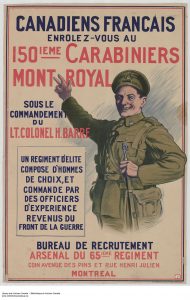
As the war dragged on the messages and images changed. A psychological approach appeared, one in which men were shamed into enlisting or their women encouraged to give them a push (Figure 12.21).

Appeals were made, too, to ethnic groups. The relationship between the Irish and the British was fraught during the Great War but that didn’t stop Canadian recruiters from imposing their expectations of loyalism on the Irish-Canadian community (Figure 12.22).
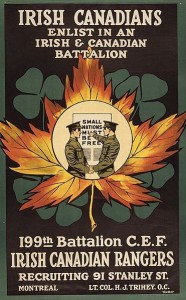
The same could be said for Canadian Jews, whose experience of Christian-Canadian tolerance included Clifford Sifton’s efforts to keep them out of the country entirely from 1896 to 1906. The emancipation (removal of civil restrictions and barriers to public service based on faith) of the Jews in Britain in 1858 is echoed here (Figure 12.23) as the warrior-to-be announces, “You have cut my bonds and set me free — Now let me help you set others FREE!”

The artwork itself was evolving: 20th-century lettering and aerial combat, along with an entirely different representative style makes an appearance in this 1916 poster (Figure 12.24).
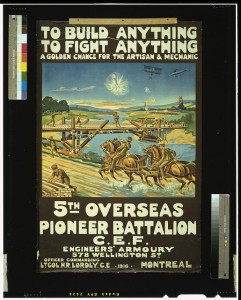
If recruitment posters could not do the job, then Victory Bonds might. The range of Victory Bond posters is staggering, and their complexity and colours are striking (Figure 12.25).

Images of children were conscripted to the task of selling Victory Bonds. A famous version of this was the British “What did you do during the Great War, Daddy?” poster (Figure 12.26).


Even at war’s end, the posters continued to appear, calling for citizens’ help to reintegrate the returning soldier (Figure 12.28).
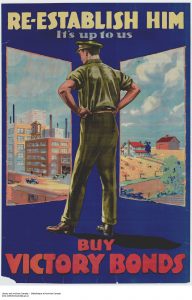
Modern artistic styles become more obvious in this 1919 painting by Frederick Etchells, Armistice Day, Munitions Centre (Figure 12.29).
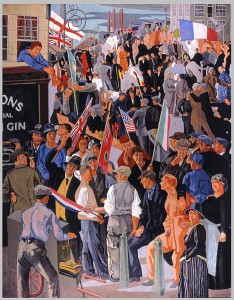
By the outbreak of World War II, Canadian art had become more mature and sophisticated. The Group of Seven were by now well established (see Section 10.14). One of their number — A.J. Casson — produced this glorious work as the collection of donations for a new generation of Victory Bonds, which got underway in 1941 (Figure 12.30).

Art-deco-meets-gothic-knights in this Department of National Defense recruitment poster (Figure 12.31).
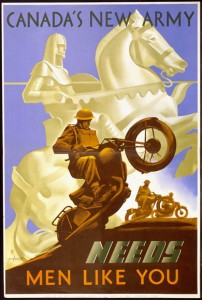
Wartime brought a variety of moral panics, including fear of spies, saboteurs, slackers, and sexually transmitted diseases. The last of these became associated with “loose women” and prostitutes, rather than with enlisted men. Campaigns against venereal diseases often portrayed women as infectious sexual predators who were sapping the strength of the nation (Figure 12.32).
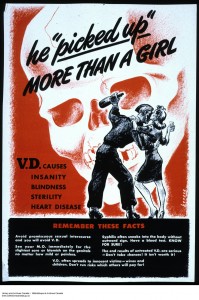
The final word goes to the Wartime Information Board, who deployed strong colours and graphics in service of the newest Victory Bonds campaign (Figure 12.33).
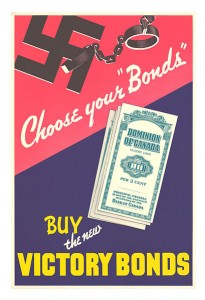
Art histories of the 20th century generally don’t provide much space for these utilitarian creations but histories of social and cultural values should. These are documents that show us the past, while shaping the past at the same time.
Key Points
- Posters became both a cultural form and an important means of communicating values, goals, and other messages in the 20th century, as the poster-art of Canada at war reveals.
Attributions
Figure 12.20
Canadiens français enrôlez-vous au 150ième Carabinier Mont-Royal : recruitment campaign (Online MIKAN no.3635539) by Library and Archives Canada, Acc. No. 1983-28-803 is in the public domain.
Figure 12.21
To the Women of Canada, Enlist Today (Online MIKAN no.3667208) by Library and Archives Canada, Acc. No. 1983-28-834 is in the public domain.
Figure 12.22
Irish Canadians enlist in an Irish and Canadian Battalion by Skeezix1000 is in the public domain.
Figure 12.23
The Jews the world over love liberty poster by Mbz1 is in the public domain.
Figure 12.24
To build anything, to fight anything … 5th Overseas Pioneer Battalion, C.E.F. by Library of Congress Prints and Photographs Division is in the public domain.
Figure 12.25
Back Him Up! Buy Victory Bonds : victory loan drive. (Online MIKAN no.2894437) by Library and Archives Canada, Acc. No. 1983-28-606 is in the public domain.
Figure 12.26
Do It Again Daddy Please! Buy Me a Victory Bond. (Online MIKAN no.3667091) by Library and Archives Canada, Acc. No. 1983-28-653 is in the public domain.
Figure 12.27
Canada WWI Victory Bonds2 (ID: cph 3g10650) by Library of Congress Prints and Photographs Division is in the public domain.
Figure 12.28
Re-establish him – It’s up to us – Buy Victory Bonds : victory loan drive. (Online MIKAN no.3635524) by Library and Archives Canada, Acc. No. 1983-28-613 is in the public domain.
Figure 12.29
Frederick Etchells – Armistice Day, Munitions Centre by Frederick Etchells / Labattblueboy is in the public domain.
Figure 12.30
Give Us the Tools and We Will Finish the Job – Help Finish the Job – Buy Victory Bonds : victory loan drive (Online MIKAN no.2834370) by Library and Archives Canada, Acc. No. 1983-30-585 is in the public domain.
Figure 12.31
Canada’s New Army – Needs Men Like You : recruitment campaign (Online MIKAN no.2834359) by Library and Archives Canada, Acc. No. 1983-30-303 is in the public domain.
Figure 12.32
He “Picked Up” More Than a Girl : sensitive campaign against venereal disease (Online MIKAN no.2851781) by Library and Archives Canada, Acc. No. 1985-35-8 is in the public domain.
Figure 12.33
Choose Your Bonds. Buy the New Victory Bonds by Labattblueboy / Wartime Information Board, Ottawa / McMaster University Libraries, Identifier: 00001665 is in the public domain.

